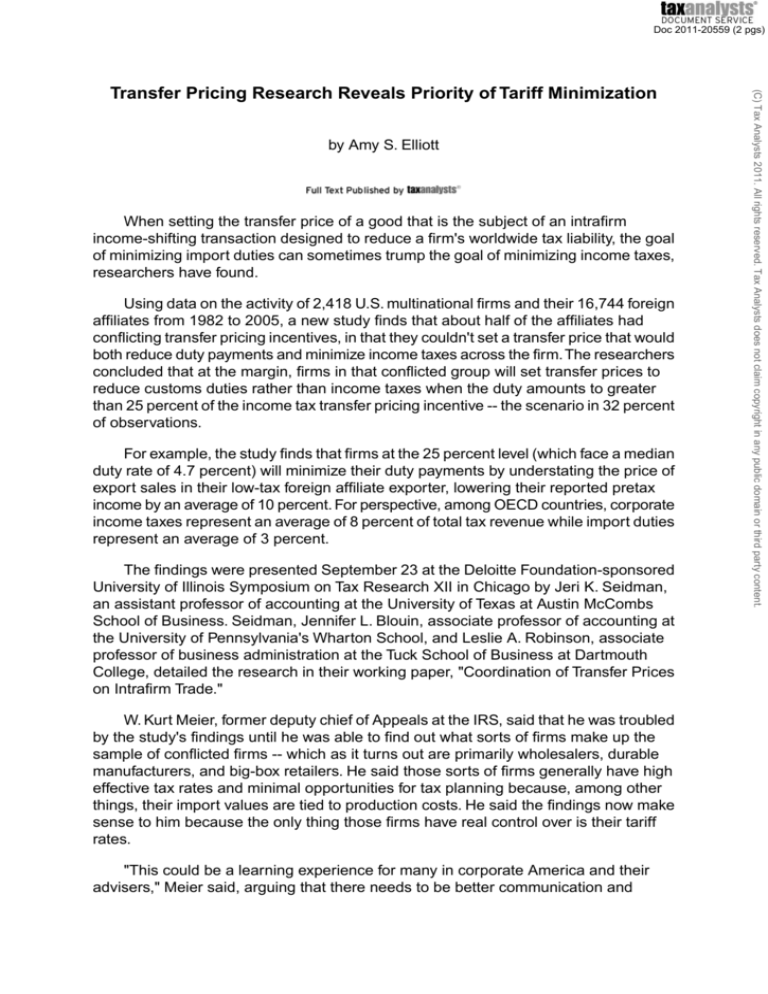
Doc 2011-20559 (2 pgs)
by Amy S. Elliott
When setting the transfer price of a good that is the subject of an intrafirm
income-shifting transaction designed to reduce a firm's worldwide tax liability, the goal
of minimizing import duties can sometimes trump the goal of minimizing income taxes,
researchers have found.
Using data on the activity of 2,418 U.S. multinational firms and their 16,744 foreign
affiliates from 1982 to 2005, a new study finds that about half of the affiliates had
conflicting transfer pricing incentives, in that they couldn't set a transfer price that would
both reduce duty payments and minimize income taxes across the firm.The researchers
concluded that at the margin, firms in that conflicted group will set transfer prices to
reduce customs duties rather than income taxes when the duty amounts to greater
than 25 percent of the income tax transfer pricing incentive -- the scenario in 32 percent
of observations.
For example, the study finds that firms at the 25 percent level (which face a median
duty rate of 4.7 percent) will minimize their duty payments by understating the price of
export sales in their low-tax foreign affiliate exporter, lowering their reported pretax
income by an average of 10 percent. For perspective, among OECD countries, corporate
income taxes represent an average of 8 percent of total tax revenue while import duties
represent an average of 3 percent.
The findings were presented September 23 at the Deloitte Foundation-sponsored
University of Illinois Symposium on Tax Research XII in Chicago by Jeri K. Seidman,
an assistant professor of accounting at the University of Texas at Austin McCombs
School of Business. Seidman, Jennifer L. Blouin, associate professor of accounting at
the University of Pennsylvania's Wharton School, and Leslie A. Robinson, associate
professor of business administration at the Tuck School of Business at Dartmouth
College, detailed the research in their working paper, "Coordination of Transfer Prices
on Intrafirm Trade."
W. Kurt Meier, former deputy chief of Appeals at the IRS, said that he was troubled
by the study's findings until he was able to find out what sorts of firms make up the
sample of conflicted firms -- which as it turns out are primarily wholesalers, durable
manufacturers, and big-box retailers. He said those sorts of firms generally have high
effective tax rates and minimal opportunities for tax planning because, among other
things, their import values are tied to production costs. He said the findings now make
sense to him because the only thing those firms have real control over is their tariff
rates.
"This could be a learning experience for many in corporate America and their
advisers," Meier said, arguing that there needs to be better communication and
(C) Tax Analysts 2011. All rights reserved. Tax Analysts does not claim copyright in any public domain or third party content.
Transfer Pricing Research Reveals Priority of Tariff Minimization
Doc 2011-20559 (2 pgs)
Dhammika Dharmapala, a professor at the University of Illinois College of Law,
said past research suggests that firms care about income tax minimization and that
the new study may need to be refined to better gauge how much tariff minimization
rather than income tax minimization motivates a particular firm's transfer pricing
decisions.
Dharmapala suggested that the researchers add back into the sample the data
from firms that do not conduct a significant amount of trade with their affiliates and use
those firms as the control group. Those firms "do not have clear tariff minimization
objectives in one direction or another, which in the author's view makes them irrelevant,"
Dharmapala said. In his view, however, those firms "essentially only have income tax
minimization objectives." He noted that that group constitutes about one-third of the
potential observations.
The study also considers how coordination of income taxes and customs duties
within a firm or a government affects transfer pricing behavior. Seidman said the study
shows that coordination strengthens the results. She said conflicted firms that have
considerable duty payments (relative to potential income tax benefits) are even more
inclined to set their transfer prices to reduce duty payments as the firm or government
goes from uncoordinated to coordinated.
"We all think of taxes as income taxes and we all think that income taxes affect
behavior. But this paper also shows that indirect taxes may affect firm behavior as
well," Seidman said. "Import duties alter firms' income-tax-motivated transfer pricing."
The data used in the study were generated from surveys of U.S. direct investment
abroad conducted by the Bureau of Economic Analysis. The study also used tariff data
from the World Bank, which gives the average tariff rate of all imports by country and
year. The paper is available at: http://www.business.illinois.edu/accountancy/events/
symposium/tax/2011/papers/Blouin_Robinson_Seidman.pdf.
(C) Tax Analysts 2011. All rights reserved. Tax Analysts does not claim copyright in any public domain or third party content.
integration within firms between income tax and customs administration. He said a firm
can spend hundreds of thousands of dollars for a transfer pricing study of a product
line and that he would think firms would be disinclined to undercut that over tariff
concerns -- not to mention the potential tax exposure of any related transfer pricing
misstatements.










